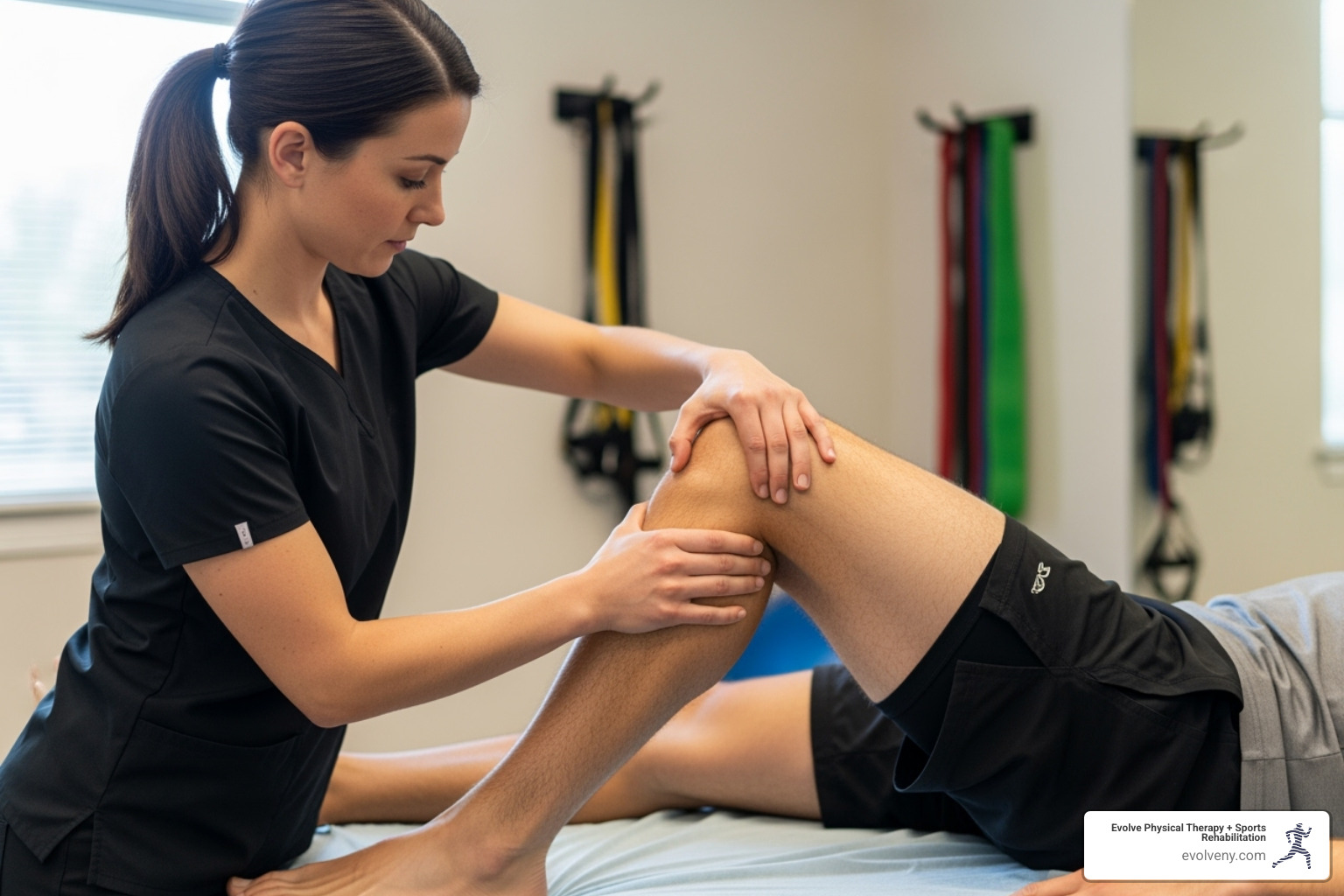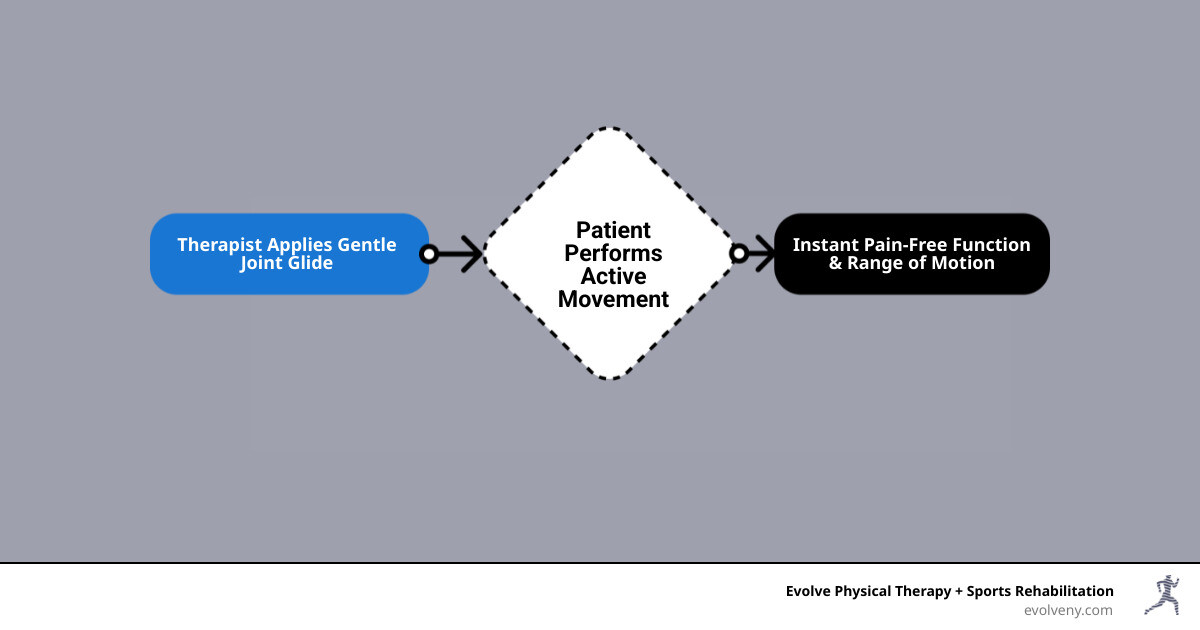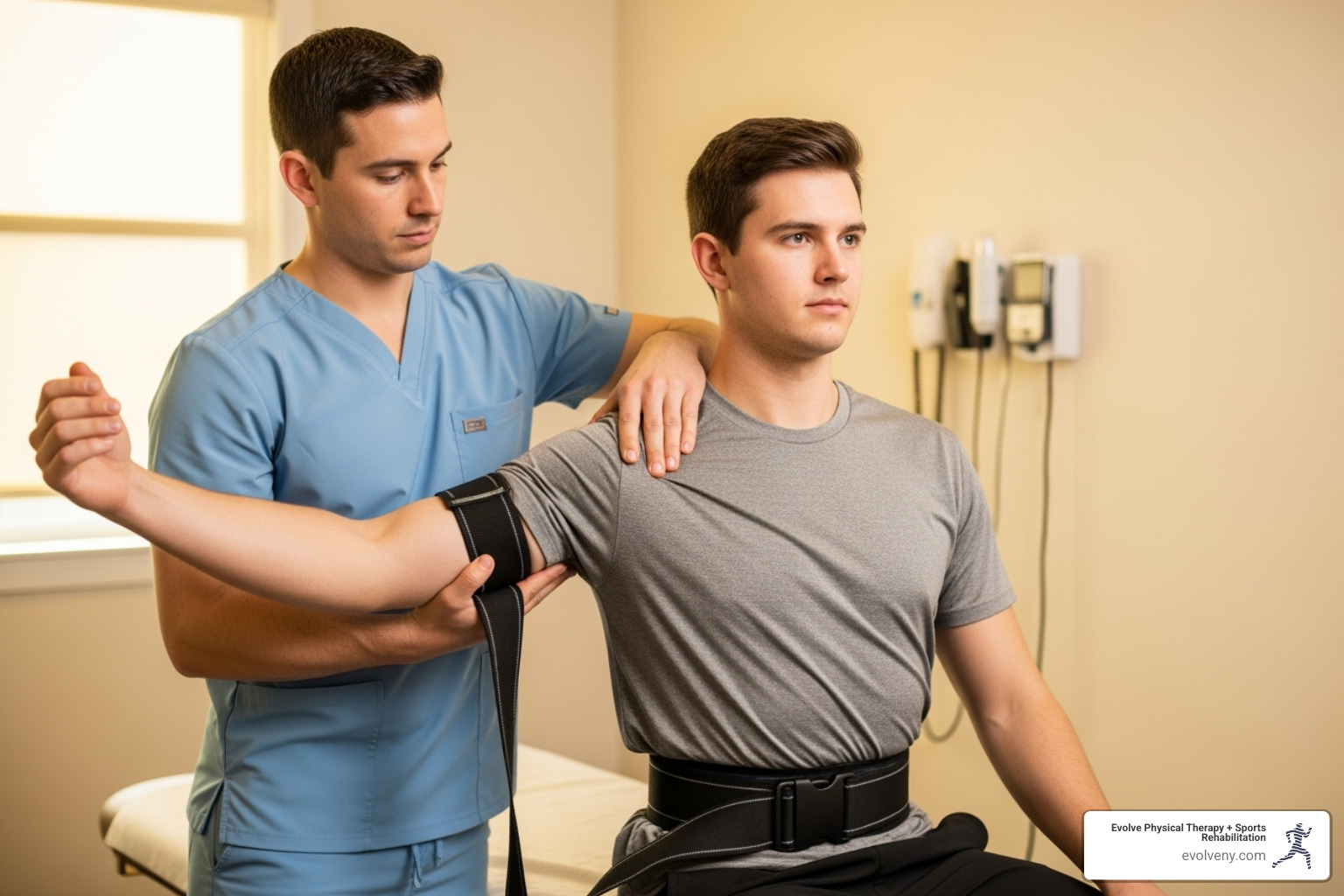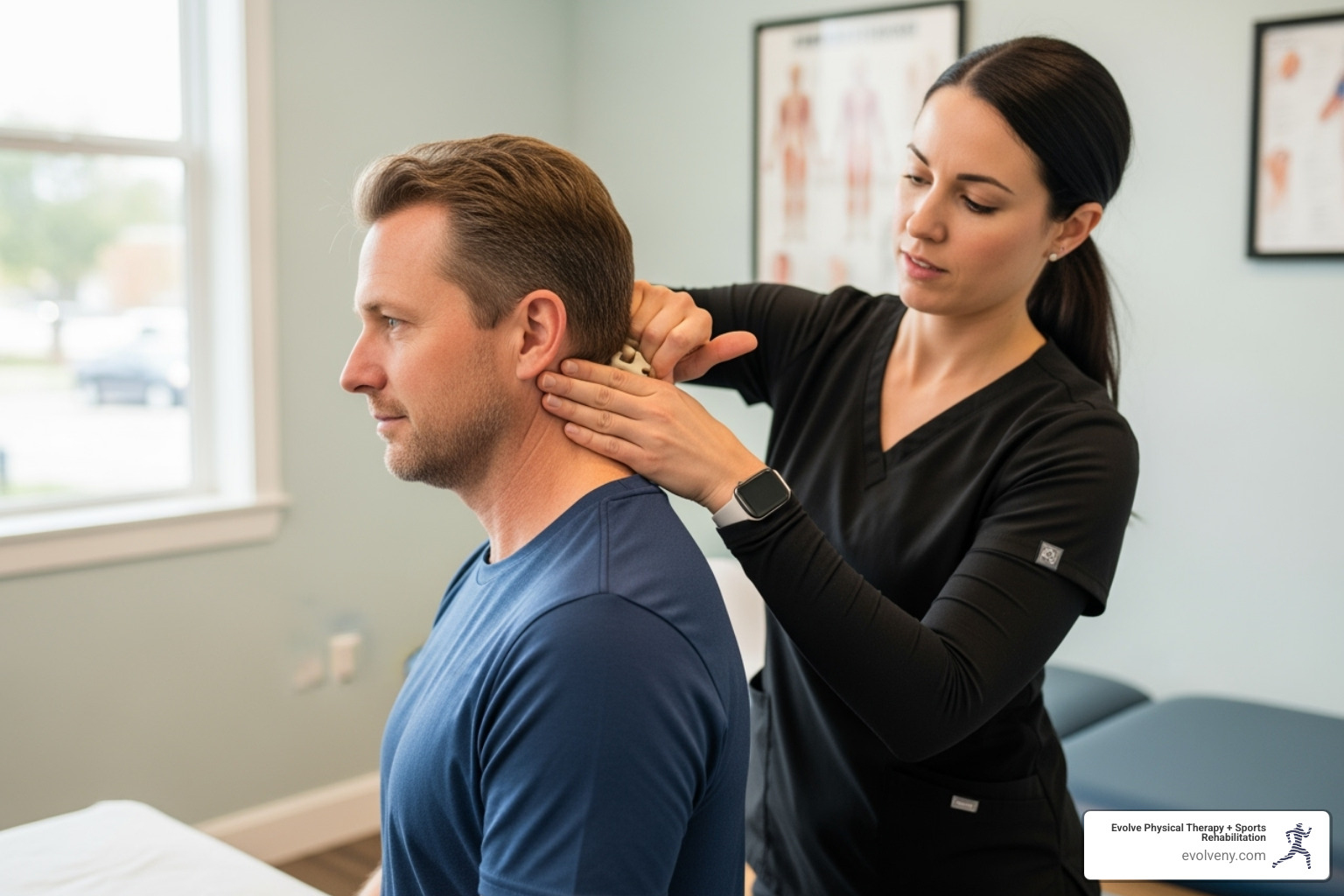Mobilizations with Movement: Your Joints Will Thank You
Why Your Joints Need Mobilizations with Movement

Mobilizations with Movement is a manual therapy technique that combines gentle joint gliding with active movement to restore pain-free function instantly. Developed by New Zealand physiotherapist Brian Mulligan in the 1980s, this approach has transformed how we treat joint dysfunction and movement restrictions.
Key Features of Mobilizations with Movement:
- Pain-free technique - No discomfort during treatment
- Instant results - Immediate improvement in movement and pain
- Long-lasting effects - Benefits persist after treatment
- Active participation - You move while the therapist guides your joint
- Self-treatment options - Learn techniques to maintain progress at home
Unlike traditional joint mobilization where you lie passively, MWM requires your active participation. The therapist applies a specific glide to your joint while you perform the previously painful or restricted movement. When done correctly, pain disappears and full range of motion returns immediately.
This technique works on the principle that many joint problems stem from minor "positional faults" - small misalignments that disrupt normal joint mechanics. By correcting these faults during movement, MWM restores proper joint tracking and eliminates pain.
I'm Lou Ezrick, founder of Evolve Physical Therapy, and I've used mobilizations with movement techniques for nearly two decades to help patients overcome chronic pain and movement restrictions that traditional approaches couldn't resolve. My experience treating complex cases in Tel Aviv and Brooklyn has shown me the remarkable power of MWM to restore function when other treatments fall short.

Unpacking the Mulligan Concept: Core Principles and Theories
When Brian Mulligan first developed his approach back in the 1980s, he revolutionized how we think about joint problems. Instead of just pushing and pulling on stiff joints, he finded something remarkable: many of our aches and pains come from tiny misalignments that we can fix while we're actually moving.
Think of it like this - your joints are supposed to glide smoothly like a well-oiled machine. But sometimes, after an injury or from poor posture, they get slightly "off track." Traditional therapy often tries to fix this by moving your joint for you while you lie still. Mobilizations with movement takes a completely different approach - we guide your joint back into its proper path while you actively use it.
This isn't just theory anymore. After decades of use across five continents, we know that MWM works through multiple pathways. It corrects mechanical problems, calms down irritated nerves, and gives patients that incredible "aha!" moment when pain-free movement returns instantly. There's something deeply empowering about feeling your body work properly again after months or years of limitations.
At Evolve Physical Therapy, we've seen countless patients light up when they experience their first pain-free shoulder raise or effortless neck turn. It's these moments that remind us why we love what we do. More info about our hands-on approach explains how we integrate these powerful techniques into comprehensive care.
The 'Positional Fault' Theory Explained
Picture trying to slide a drawer that's slightly crooked in its frame. It catches, it sticks, and sometimes it just won't budge. Your joints can develop similar problems - what we call positional faults.
These aren't the dramatic dislocations you might see in emergency rooms. We're talking about subtle shifts that might not even show up on X-rays. Maybe your shoulder blade isn't sitting quite right, or your wrist bones aren't tracking perfectly when you bend your hand. These tiny misalignments can create big problems.
The beauty of understanding positional faults is realizing they're fixable. When we apply mobilizations with movement, we're essentially helping that "crooked drawer" slide smoothly again. We gently guide your joint back into its happy place while you move it through the motion that was causing trouble.
What's amazing is how quickly your body responds. Once we find the right direction and amount of guidance, that painful movement often becomes completely comfortable - sometimes within seconds. Your joint remembers how it's supposed to move, and the pain simply melts away.
The Guiding Principles: PILL and CROCKS
Every effective treatment approach needs clear guidelines, and mobilizations with movement follows two essential frameworks that keep both therapists and patients on track.
The PILL response is our gold standard for success. If we don't see all three components, we know this particular approach isn't the right fit for your specific problem. No forcing, no "working through the pain" - we simply try a different strategy. The criteria are:
- Pain-free: The movement must be completely pain-free. If it hurts, we're not doing it right.
- Instant: You should feel the difference immediately, not days later.
- Long-lasting: The positive changes should stick around after we finish the technique.
For therapists applying these techniques, the CROCKS principles ensure safe, effective treatment:
- Contraindications: We always check for conditions that would make this technique unsuitable.
- Repetitions: Repetitions help your nervous system learn the new, pain-free movement pattern.
- Overpressure: Gentle overpressure at the end of your available range can boost the lasting effects.
- Communication: Your feedback is crucial every step of the way.
- Knowledge: Our knowledge of anatomy and biomechanics guides precise application.
- Sustained mobilization: We maintain that gentle guidance throughout your entire movement.
These aren't just academic concepts - they're practical tools that help us deliver the remarkable results MWM is known for.
How MWM Differs from Traditional Mobilization
The difference between mobilizations with movement and traditional joint mobilization is like comparing learning to ride a bike with training wheels versus having someone push your bike while you sit on it. While both can be helpful, they operate on fundamentally different principles.
Here's a quick comparison:
| Feature | Mobilizations with Movement (MWM) | Traditional Mobilization |
|---|---|---|
| Patient Involvement | Active - You perform the movement. | Passive - The therapist moves your joint for you. |
| Application | During active, functional movement. | On a static, resting joint. |
| Goal | Restore immediate, pain-free function. | Reduce stiffness and improve passive range. |
| Feedback | Instant functional change (e.g., increased motion). | Gradual symptom response over time. |
| Pain Principle | Strictly pain-free; pain indicates incorrect technique. | May involve some discomfort to achieve tissue changes. |
In MWM, you're the star of the show, actively participating in your recovery by performing the very movement that was causing trouble, now made pain-free. This real-time correction of movement patterns is not only more comfortable but also more functionally relevant to your daily life, as your nervous system learns the new, correct way to move without protective responses.
The Power of Mobilizations with Movement in Action
When you're dealing with pain or movement restrictions, you want results - and you want them fast. That's exactly what mobilizations with movement delivers. This powerful technique has transformed countless lives at our clinic, helping people overcome musculoskeletal disorders that seemed impossible to resolve.
What makes MWM so remarkable is its versatility. Whether you're struggling with chronic shoulder pain, can't grip a coffee cup without wincing, or find yourself limping after an ankle sprain, mobilizations with movement offers a path forward. The technique works by addressing the root cause of your movement dysfunction, not just masking the symptoms.
The research backing MWM continues to grow stronger each year. Studies consistently show that when applied correctly, this approach leads to immediate pain relief and lasting functional improvements. What used to take weeks or months of traditional therapy can often be achieved in a single session - though we always follow up to ensure those gains stick around.
One of the most empowering aspects of mobilizations with movement is how it teaches you to become an active participant in your recovery. Many techniques can be adapted for self-treatment, giving you tools to maintain your progress at home. It's like learning to tune your own instrument instead of always needing someone else to do it for you.
For those who love diving deep into the science, you can explore A comprehensive list of supporting research that supports these techniques.
Applying mobilizations with movement for Shoulder Pain
Your shoulder is an incredible joint - it can move in more directions than almost any other joint in your body. But when something goes wrong, that same complexity can make shoulder problems particularly frustrating. Simple tasks like reaching into a high cabinet or putting on a shirt can become painful reminders of what you've lost.
Shoulder impingement syndrome is one of the most common culprits behind shoulder pain. It feels like something is getting pinched or squeezed inside your shoulder every time you lift your arm. With mobilizations with movement, we apply a gentle lateral glide to your upper arm bone while you perform the exact movement that usually causes pain. It's like creating a little extra space in a crowded elevator - suddenly everything moves smoothly again.
Frozen shoulder, or adhesive capsulitis, presents a different challenge. Your shoulder capsule becomes thick and tight, making even small movements feel like you're fighting against invisible restraints. MWM techniques help us gently coax your shoulder back to life, particularly improving flexion and abduction - those crucial movements that let you reach forward and out to the side.
The change can be dramatic. I've watched patients walk into our clinic barely able to lift their arm to shoulder height, then leave the same day reaching overhead pain-free. It never gets old seeing that look of amazement on someone's face when they realize their shoulder works again.

At Evolve Physical Therapy, we've helped hundreds of people reclaim their shoulder function. Learn more about our specialized approach with Physical Therapy for Shoulder Pain and find How does mobilization with movement improve shoulder flexion.
A Solution for Tennis Elbow (Lateral Epicondylitis)
Don't let the name fool you - you don't need to play tennis to get tennis elbow. This frustrating condition, officially called lateral epicondylitis, can strike anyone who uses their hands and arms repetitively. Office workers, gardeners, painters, and yes, tennis players all know the distinctive ache along the outside of their elbow.
The real kicker with tennis elbow is how it affects your grip strength. Suddenly, simple tasks like opening a jar or shaking hands become painful reminders of your condition. You might find yourself avoiding certain movements altogether, which only makes things worse over time.
Here's where mobilizations with movement truly shines. We apply a specific lateral glide of the ulna - that's one of your forearm bones - while you actively grip or extend your wrist. The combination of our gentle guidance and your active movement often produces immediate pain relief that seems almost magical.
I've had patients who couldn't shake my hand without grimacing at the start of a session, then grip firmly and pain-free by the end. The technique works by correcting the subtle tracking problems in your elbow joint that develop with repetitive stress. It's like realigning the wheels on your car - suddenly everything runs smoothly again.
The beauty of this approach is that we can often teach you a modified version to use at home, helping you maintain those gains between sessions. It puts you back in control of your recovery.
If elbow pain is limiting your daily activities, we're here to help. Explore our comprehensive Physical Therapy for Elbow Pain services.
Easing Wrist, Hand, and Ankle Issues
Sometimes the smallest joints cause the biggest problems. Your wrists, hands, and ankles might be compact, but when they're not working properly, they can turn everyday activities into major challenges. Fortunately, mobilizations with movement works beautifully on these intricate joints too.
Carpal tunnel syndrome affects millions of people, causing that distinctive numbness, tingling, and pain in your hand and fingers. Traditional treatments often focus on rest and splinting, but MWM takes a different approach. We apply gentle glides to your wrist bones while you perform movements that typically trigger your symptoms. This helps improve median nerve mobility and reduces the compression that's causing your problems.
The results can be remarkable. Patients often notice their fingers feel more normal and their grip becomes stronger within just a few sessions. It's incredibly rewarding to see someone regain the ability to type comfortably or sleep through the night without waking up with numb hands.
Wrist pain from other causes responds well too. Whether you're dealing with a old injury that never quite healed right or developing stiffness from repetitive work, MWM can help restore that smooth, pain-free movement you've been missing.
Don't overlook your ankles either. These hardworking joints take a beating every day, supporting your entire body weight with each step. Ankle sprains are incredibly common, but the stiffness that lingers afterward doesn't have to be permanent. MWM techniques can quickly restore lost motion and get you walking, running, or dancing without that nagging stiffness. For comprehensive ankle and foot care, visit our Physical Therapy for Ankle Pain page.
The MWM Toolkit: Understanding SNAGs and NAGs
When it comes to spinal problems, mobilizations with movement takes on a special form through two powerful techniques: SNAGs and NAGs. These approaches are specifically designed for your spine and can work wonders for neck pain, back stiffness, and even those stubborn headaches that seem to come from nowhere.
Your spine is incredibly complex - it's not just one joint, but dozens working together. When even one segment isn't moving quite right, it can throw off your entire system. That's where SNAGs and NAGs come in. They help us address these spinal hiccups with the same pain-free philosophy that makes all mobilizations with movement so effective.
What makes spinal MWM techniques particularly exciting is their ability to tackle problems that often leave people feeling frustrated. You know that nagging neck pain that flares up when you turn to check your blind spot? Or that morning stiffness that makes getting out of bed feel like you're 90 years old? SNAGs and NAGs can often provide immediate relief for these exact issues.

What are SNAGs (Sustained Natural Apophyseal Glides)?
Think of SNAGs as the "active partner" in spinal mobilizations with movement. The name might sound technical, but the concept is beautifully simple: we apply a sustained glide to a specific spinal segment while you actively move in a way that was previously painful or restricted.
Here's how it works in real life. Let's say you can't turn your head to the right without sharp pain - maybe it happened after sleeping funny or sitting at your computer too long. During a SNAG, I'll place my hands on a specific vertebra in your neck and apply a gentle, sustained pressure in just the right direction. While I maintain that pressure, you slowly turn your head to the right.
The magic happens when that painful movement suddenly becomes pain-free. It's like we've found the perfect key to open up your stuck joint. This technique is particularly effective because it happens in weight-bearing positions - meaning you're sitting or standing normally, which helps your body learn the corrected movement pattern for real-world activities.
SNAGs work beautifully for restoring spinal mobility in all regions of your spine. Whether it's neck rotation, looking up at the ceiling, or bending forward to tie your shoes, SNAGs can often restore these movements instantly and comfortably.
One of my favorite applications is for headaches that originate from the upper neck. These cervical headaches often respond dramatically to the right SNAG technique. I've seen patients walk in with splitting headaches and leave completely pain-free after just one session.
If you're struggling with persistent neck or back pain, our specialized approach can make all the difference. Learn more about our Physical Therapy for Neck Pain and Physical Therapy for Back Pain services.
What are NAGs (Natural Apophyseal Glides)?
While SNAGs are all about sustained pressure during active movement, NAGs take a different approach. These are oscillatory mobilizations - think of them as gentle, rhythmic waves of movement applied to your spinal joints.
NAGs work primarily on the neck and upper back, and they're particularly good at addressing that general stiffness and achiness that doesn't have one specific painful movement. Instead of the sustained pressure of a SNAG, we apply rhythmic, repetitive glides to the spinal segment in mid-to-end range positions.
These techniques are usually performed while you're lying down in non-weight-bearing positions, making them perfect for when movement is too uncomfortable or when we need to focus on reducing pain and stiffness before progressing to more active techniques.
The gentle oscillations work by stimulating the nerve receptors in your joints, which can help block pain signals and improve how your tissues move. It's like giving your spine a gentle massage from the inside out. While NAGs still follow our pain-free principles, they're often the technique of choice when you're dealing with more diffuse discomfort rather than sharp, movement-specific pain.
Both SNAGs and NAGs are powerful tools in our toolkit, and the beauty is that we can often teach you modified versions to use at home. This means you're not dependent on coming to the clinic every time your symptoms flare up - you have the power to maintain your progress independently.
Frequently Asked Questions about Mobilizations with Movement
When patients first hear about mobilizations with movement, they naturally have questions. After nearly two decades of using these techniques, I've found that understanding what to expect makes the experience much more comfortable and effective. Let me address the most common concerns we hear at Evolve Physical Therapy.
Is Mobilization with Movement painful?
This is the question I hear most often, and I'm always excited to answer it: absolutely not! The beauty of mobilizations with movement lies in its core principle - if it hurts, we're not doing it right.
Pain-free movement is the foundation of everything we do with MWM. When I apply a mobilization glide to your joint, you should feel immediate relief, not discomfort. If you experience any pain during the technique, it tells me we haven't found the correct angle or direction of glide yet, or perhaps MWM isn't the right approach for your specific issue.
I constantly communicate with my patients during treatment. "How does that feel?" and "Any pain with that movement?" are questions you'll hear repeatedly. Your feedback guides everything I do. The absence of pain isn't just nice to have - it's our primary indicator that the technique is working correctly.
This approach is completely different from the "no pain, no gain" mentality you might expect. We're not working through pain; we're eliminating it entirely while you move.
How quickly will I see results from MWM?
Here's where mobilizations with movement truly shines - the results are often instantaneous. The "I" in our PILL principle stands for "Instant," and that's exactly what we aim for in every session.
I've had patients walk into my clinic barely able to lift their arm overhead due to shoulder pain, and within minutes of applying the right MWM technique, they're reaching toward the ceiling with a huge smile on their face. It's one of the most rewarding aspects of what I do.
You should notice an immediate improvement in your range of motion during the first application. If we don't see that instant change, we adjust our approach until we find what works for your specific joint dysfunction. The goal isn't just temporary relief either - these improvements should persist after I remove my hands from your joint.
While dramatic changes often happen in the first session, most patients benefit from a series of treatments to fully resolve the underlying issue and learn self-treatment techniques to maintain their progress at home.
Who is qualified to perform Mobilizations with Movement?
This is a crucial question for your safety and treatment success. Mobilizations with movement requires specialized training beyond basic physical therapy education. Not every therapist is qualified to perform these techniques safely and effectively.
At Evolve Physical Therapy, our licensed physical therapists have completed advanced manual therapy training, including specific education in the Mulligan Concept. This specialized knowledge is essential because MWM isn't just about applying pressure - it requires a deep understanding of joint biomechanics, anatomy, and the ability to assess exactly where and how each joint needs to be guided.
Proper assessment comes first. We need to identify potential "positional faults" in your joints and determine whether MWM is appropriate for your specific condition. The precision required to find the exact angle and direction of mobilization that eliminates your pain takes years of training and practice to master.
Our expertise allows us to recognize immediately when a technique is working and when we need to try a different approach. This knowledge and experience ensures you get the safest, most effective treatment possible.
Conclusion
When you're struggling with joint pain or movement restrictions, mobilizations with movement offers something truly special – a path back to pain-free function that feels almost magical in its simplicity. This remarkable approach doesn't just mask your symptoms; it addresses the root cause by gently correcting those subtle "positional faults" that can turn everyday movements into painful ordeals.
What makes MWM so powerful is how it empowers you to take an active role in your recovery. Instead of lying passively while treatment happens to you, you become a partner in the healing process. You move while we guide your joints back to their happy place – and the results speak for themselves.
The pain-free restoration of function isn't just a nice idea; it's the fundamental promise of this technique. When we see patients walk in unable to lift their arm overhead or grip a coffee cup without wincing, then watch them perform these movements effortlessly just minutes later, it never gets old. These aren't temporary fixes either – the long-lasting results mean you can return to your daily activities with confidence.
Perhaps most importantly, MWM teaches you self-treatment techniques that put the power of healing literally in your own hands. You'll learn how to maintain your progress and even prevent future flare-ups, giving you tools that last a lifetime.
At Evolve Physical Therapy + Sports Rehabilitation, our skilled therapists have mastered these advanced mobilizations with movement techniques through years of specialized training and hands-on experience. We've witnessed countless "impossible" cases turn around, from frozen shoulders that suddenly move freely to tennis elbows that stop aching overnight.
Our approach goes beyond just applying techniques – we believe in truly understanding your unique situation and creating a treatment plan that makes sense for your life. Whether you're dealing with a nagging shoulder issue, stubborn elbow pain, or chronic neck stiffness, we're here to help you move better and live pain-free.
Ready to experience what it feels like when your joints work the way they're supposed to? Learn more about our physical therapy services and find how mobilizations with movement can transform your relationship with movement itself.

